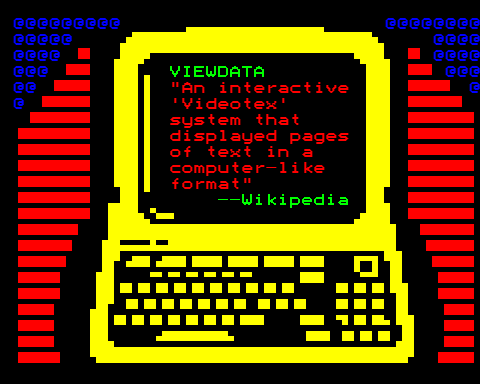|
Alex (videotex Service)
Alex was an interactive videotex information service offered by Bell Canada in market research from 1988 to 1990 and thence to the general public until 1994. The ''Alextel'' terminal was based on the French Minitel terminals, built by Northern Telecom and leased to customers for $7.95/month. It consisted of a CRT display, attached keyboard, and a 1200 bit/s modem for use on regular phone lines. In 1991 proprietary software was released for IBM PCs that allowed computer users to access the network. Communications on the Alex network was via DATAPAC X.25 protocol. The system operated in the same fashion as Minitel, whereby users connected to various content providers over the X.25 network and thus access was normally through a local telephone number. The most popular (and most expensive) sites were chat rooms. Using the service could cost as much as per minute. Also offered was an electronic white pages and yellow pages directory. Many users terminated their subscription upon re ... [...More Info...] [...Related Items...] OR: [Wikipedia] [Google] [Baidu] |
Northern Telecom
Northern may refer to the following: Geography * North, a point in direction * Northern Europe, the northern part or region of Europe * Northern Highland, a region of Wisconsin, United States * Northern Province, Sri Lanka * Northern Range, a range of hills in Trinidad * Northern State (Sudan), one of the 18 wilayat (states) of Sudan Schools * Northern Collegiate Institute and Vocational School (NCIVS), a school in Sarnia, Canada * Northern Secondary School, Toronto, Canada * Northern Secondary School (Sturgeon Falls), Ontario, Canada * Northern University (other), various institutions * Northern Guilford High School, a public high school in Greensboro, North Carolina Companies * Arriva Rail North, a former train operating company in northern England * Chemins de fer du Nord (Northern Railway Company), a former rail transport company in northern France * Nord-Aviation (Northern Aviation), a former state-owned French aircraft manufacturer. * Compañía de los Caminos ... [...More Info...] [...Related Items...] OR: [Wikipedia] [Google] [Baidu] |
Dumb Terminal
A computer terminal is an electronic or electromechanical hardware device that can be used for entering data into, and transcribing data from, a computer or a computing system. Most early computers only had a front panel to input or display bits and had to be connected to a terminal to print or input text through a keyboard. Teleprinters were used as early-day hard-copy terminals and predated the use of a computer screen by decades. The computer would typically transmit a line of data which would be printed on paper, and accept a line of data from a keyboard over a serial or other interface. Starting in the mid-1970s with microcomputers such as the Sphere 1, Sol-20, and Apple I, display circuitry and keyboards began to be integrated into personal and workstation computer systems, with the computer handling character generation and outputting to a CRT display such as a computer monitor or, sometimes, a consumer TV, but most larger computers continued to require termin ... [...More Info...] [...Related Items...] OR: [Wikipedia] [Google] [Baidu] |
Telecommunications In Canada
Present-day telecommunications in Canada include telephone, radio, television, and internet usage. In the past, telecommunications included telegraphy available through Canadian Pacific and Canadian National. History The history of telegraphy in Canada dates back to the Province of Canada. While the first telegraph company was the Toronto, Hamilton and Niagara Electro-Magnetic Telegraph Company, founded in 1846, it was the Montreal Telegraph Company, controlled by Hugh Allan and founded a year later, that dominated in Canada during the technology's early years. Following the 1852 Telegraph Act, Canada's first permanent Transatlantic telegraph cable, transatlantic telegraph link was a submarine cable built in 1866 between History of Ireland (1801–1923), Ireland and Newfoundland Colony, Newfoundland. Telegrams were sent through networks built by Canadian Pacific Railway, Canadian Pacific and Canadian National. In 1868 Montreal Telegraph began facing competition from the ne ... [...More Info...] [...Related Items...] OR: [Wikipedia] [Google] [Baidu] |
Legacy Systems
Legacy or Legacies may refer to: Arts and entertainment Comics * "Batman: Legacy", a 1996 Batman storyline * ''DC Universe: Legacies'', a comic book series from DC Comics * ''Legacy'', a 1999 quarterly series from Antarctic Press * ''Legacy'', a 2003–2005 series released by Dabel Brothers Productions * Legacy, an alternate name for the DC supervillain Wizard (DC Comics), Wizard * Legacy (Marvel Comics), an alias used by Genis-Vell, better known as Captain Marvel * Marvel Legacy, a comic book line introduced in 2017 * ''Star Wars: Legacy'', a 2006 series from Dark Horse * ''X-Men: Legacy'', a 1991 series from Marvel Comics * Legacy Virus, a fictional virus from the Marvel Universe Film * ''Legacy'', a 1975 American film starring Joan Hotchkis * ''Legacy: A Mormon Journey'', a 1990 film produced by The Church of Jesus Christ of Latter-day Saints * Legacy (1998 film), ''Legacy'' (1998 film), an American film starring David Hasselhoff * Legacy (2000 film), ''Legacy'' (2000 film), ... [...More Info...] [...Related Items...] OR: [Wikipedia] [Google] [Baidu] |
1994 Disestablishments In Canada
The year 1994 was designated as the "International Year of the Family" and the "International Year of Sport and the Olympic Charter, Olympic Ideal" by the United Nations. In the Line Islands and Phoenix Islands of Kiribati, 1994 had only 364 days, omitting December 31. This was due to an adjustment of the International Date Line by the Kiribati government to bring all of its territories into the same calendar day. Events January * January 1 ** The North American Free Trade Agreement (NAFTA) is established. ** Beginning of the Zapatista uprising in Mexico. * January 8 – ''Soyuz TM-18'': Valeri Polyakov begins his 437.7-day orbit of the Earth, eventually setting the world record for days spent in orbit. * January 11 – The Irish government announces the end of a 15-year broadcasting ban on the Provisional Irish Republican Army and its political arm Sinn Féin. * January 14 – U.S. President Bill Clinton and Russian President Boris Yeltsin sign the Kremlin accords, which ... [...More Info...] [...Related Items...] OR: [Wikipedia] [Google] [Baidu] |
1988 Establishments In Canada
1988 was a crucial year in the early history of the Internet—it was the year of the first well-known computer virus, the Morris worm, 1988 Internet worm. The first permanent intercontinental Internet link was made between the United States (National Science Foundation Network) and Europe (Nordunet) as well as the first Internet-based chat protocol, Internet Relay Chat. The concept of the World Wide Web was first discussed at CERN in 1988. The Soviet Union began its major deconstructing towards a mixed economy at the beginning of 1988 and began its Dissolution of the Soviet Union, gradual dissolution. The Iron Curtain began to disintegrate in 1988 as People's Republic of Hungary, Hungary began allowing freer travel to the Western world. The first extrasolar planet, Gamma Cephei Ab (confirmed in 2003), was detected this year and the World Health Organization began its mission to Eradication of polio, eradicate polio. Global warming also began to emerge as a more significant ... [...More Info...] [...Related Items...] OR: [Wikipedia] [Google] [Baidu] |
ICON (microcomputer)
The ICON (also the CEMCorp ICON, Burroughs ICON, and Unisys ICON, and nicknamed the bionic beaver) was a networked personal computer built specifically for use in schools, to fill a standard created by the Ontario Ministry of Education. It was based on the Intel 80186 CPU and ran an early version of QNX, a Unix-like operating system. The system was packaged as an all-in-one machine similar to the Commodore PET, and included a trackball for mouse-like control. Over time, a number of GUI-like systems appeared for the platform, based on the system's NAPLPS-based graphics system. The ICON was widely used in the mid to late 1980s, but disappeared after that time with the widespread introduction of PCs and Apple Macintoshes. History Development Origin In 1981, four years after the first microcomputers for mainstream consumers appeared, the Ontario Ministry of Education sensed that microcomputers could be an important component of education. In June the Minister of Educ ... [...More Info...] [...Related Items...] OR: [Wikipedia] [Google] [Baidu] |
Viewdata
Viewdata is a Videotex implementation. It is a type of information retrieval service in which a subscriber can access a remote database via a common carrier channel, request data and receive requested data on a video display over a separate channel. Samuel Fedida, who had the idea for Viewdata in 1968, was credited as inventor of the system which was developed while working for the British Post Office which was the operator of the national telephone system. The first prototype became operational in 1974. The access, request and reception are usually via common carrier broadcast channels. This is in contrast with teletext. Design Viewdata offered a display of 40×24 characters, based on ISO 646 (IRV IA5) – 7 bits with no accented characters. Originally, Viewdata was accessed with a special purpose terminal (or emulation software) and a modem running at ITU-T V.23 speed (1,200 bit/s down, 75 bit/s up). By 2004, it was normally accessed over TCP/IP using Viewdata clien ... [...More Info...] [...Related Items...] OR: [Wikipedia] [Google] [Baidu] |
Telidon
Telidon (from the Greek words τῆλε, ''tele'' "at a distance" and ἰδών, ''idon'' "seeing") was a videotex/teletext service developed by the Canada, Canadian Communications Research Centre Canada, Communications Research Centre (CRC) during the late 1970s and supported by commercial enterprises led by Infomart in the early 1980s. Most work on the system ended after 1985, having failed to build critical mass. The CRC referred to Telidon as a "second generation" videotex system, offering improved performance, 2D colour graphics, multilingual support and a number of different interactivity options supported on various hardware. With additional features added by AT&T Corporation, and 16 other contributors in North America and supported by the Federal Government, Telidon was redefined as a protocol and became the NAPLPS standard. A number of Telidon systems were rolled out, including GRASSROOTS for the Province of Manitoba, SOI for Venezuela, Compuserve, LA Times in Californi ... [...More Info...] [...Related Items...] OR: [Wikipedia] [Google] [Baidu] |
Prestel
Prestel was the Brand#Brand names and trademark, brand name of a videotex service launched in the UK in 1979 by BT Group#Post Office Telecommunications, Post Office Telecommunications, a division of the British Post Office Limited#History, Post Office. It had around 95,500 attached terminals at its peak, and was a forerunner of the internet-based online services developed in the late 20th and early 21st centuries. Prestel was discontinued in 1994 and its assets sold by BT Group, British Telecom to a company consortium. A subscriber to Prestel used an adapted TV set with a keypad or keyboard, a dedicated terminal, or a microcomputer to interact with a central database via an ordinary Telephone line, phoneline. Prestel offered hundreds of thousands of pages of general and specialised information, ranging from consumer advice to financial data, as well as services such as home banking, online shopping, travel booking, telesoftware, and messaging. In September 1982, to mark I ... [...More Info...] [...Related Items...] OR: [Wikipedia] [Google] [Baidu] |





